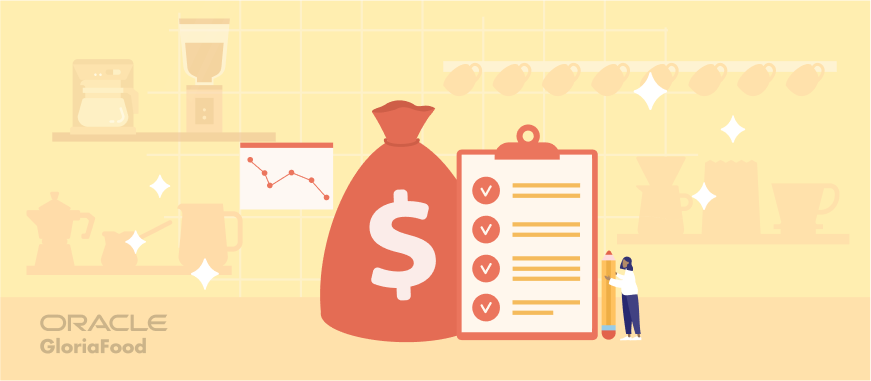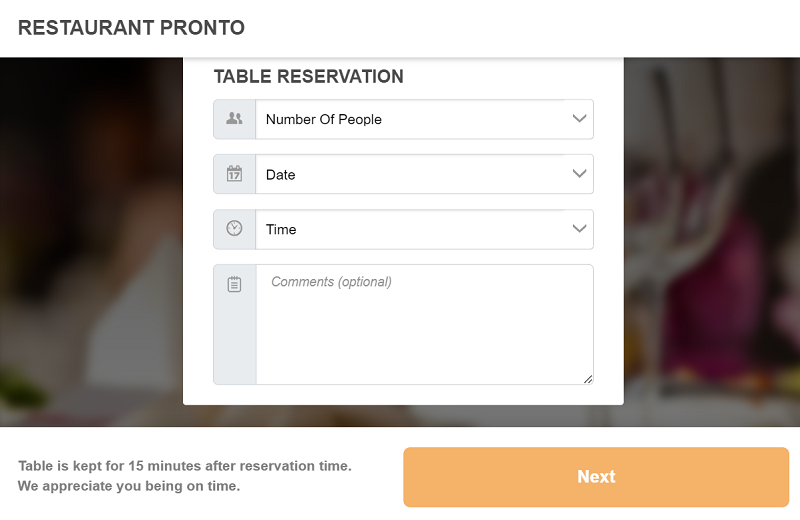- 1.Why you must efficiently manage your restaurant finances
- 2.10 Tips for mastering restaurant finance management
- Create a thorough restaurant budget
- Set up financial goals
- Conduct regular audits
- Invest in technology
- Price your menu items for profit
- Manage your inventory and food costs
- Reduce your labor costs
- Choose efficient equipment
- Have a safety net
- Be open to trends and change
- 3.Final Words
Owning a restaurant is often a balancing act. You must serve delicious food and keep customers happy while making a big enough profit to keep your business open for years to come.
But the restaurant industry is known for very small profit margins, so every penny counts.
In this article, you will learn the basics of restaurant finance management and find tips on decreasing your costs:
Why you must efficiently manage your restaurant finances
Restaurant finance management is as important as having an irresistible menu and creating a unique experience for your clients. It not only gives you a better view of your restaurant’s profitability, but it also:
- Helps you control costs: when you are aware of how much you spend on every aspect of your business, you can identify great opportunities to reduce costs without affecting your restaurant’s popularity;
- Guarantees you comply with local laws and requirements: if you are on top of your finances, you surely have accurate record-keeping that will protect you from any penalties or fines;
- Assists you in making data-driven decisions: you won’t have to guess what changes you should make to better your restaurant, your gathered data will point you in the right direction;
- Helps you achieve goals: you can set up restaurant KPIs and ratios that you monitor often to ensure you accomplish all your goals;
- Maintain a successful business long-term: by having a firm grip on your finances, you make sure you remain a profitable restaurant even in such a competitive industry.
10 Tips for mastering restaurant finance management
Reducing costs should always be at the top of your mind when you make any decision regarding your business. Follow these tips to ace restaurant finance management and improve profit:
1. Create a thorough restaurant budget
Restaurant budgeting is a great way to keep track of your expenses. As you set up a budget at the start for all the expected costs, you will know what to prioritize when a challenge comes. And you will encounter many problems.
But by relying on the initial budget and being open to change, you can overcome everything. Here are the most relevant costs you should have a complete budgeting plan for:
- Restaurant overhead costs: these are expenses that you pay even when your restaurant is not open;
- Restaurant food costs: they amount to a big part of your budget and should be kept under strict supervision;
- Restaurant labor costs: you must work to keep them at a minimum by efficiently managing your team;
- Restaurant marketing costs: the expenses vary from month to month, but there are many options to spend less and get great results.
2. Set up financial goals
It can be easy to get distracted from the main goal when you run a restaurant. The small problems that you have to deal with daily such as inventory problems or disgruntled customers will take your attention away from the end purpose.
That’s why it will be useful to set up specific financial goals. They should be measurable, achievable, relevant, and timely. Once you decide on a goal, you must also come up with a plan to achieve it.
For example, let’s say the goal is to increase sales by 2%. To achieve it, you will:
- Add promotions to your menu;
- Invest in email marketing;
- Be more active and have a contest on social media.
Read more: How to Set Restaurant Goals and Lead Your Business to Success
3. Conduct regular audits
Creating a budget and setting up goals is a great start, but for efficient restaurant finance management, you must monitor your costs and spending. One effective method to keep track of your business expenses is opening a separate business bank account for your restaurant, organizing receipts, categorizing expenses, using expense tracking software, and more.
Instead of auditing important information just once a month, start looking daily or weekly at:
- Financial statements
- Balance sheets
- Income
- Cash flow statements
When you monitor them, try to identify:
- Patterns: are there specific hours when clients buy less or more? What are your most popular items?
- Correlation: when you noticed an increase in sales, what else happened at that moment? Maybe you had a promotion running?
- Ways to improve: if you notice something works, replicate it. If you identify a problem, take time to find short-term and long-term solutions.
4. Invest in technology
There is a reason our society has become very reliant on technology. Because it is helpful. Not only does it make people’s jobs easier, but it also helps businesses save money.
If you want to cut costs at your restaurant while also making processes more efficient, you will need the following technology:
- An online ordering system: to increase sales, selling your food online is a must. But forget about taking orders by phone which leads to many errors and third party-delivery apps which cut into your profit. Instead, opt for the free online ordering system from GloriaFood that is easy to use for both you and your customers. You can add it to your website in less than 10 minutes:

- A table booking system: fill all of your tables by allowing customers to book a seat online, in just a few clicks. To increase table turnover and sell more in the same period, use the table reservation system from GloriaFood which allows clients to pre-order and pay when they book a table.
- A point-of-sale system: make your team work faster and more efficiently by implementing a POS system that will allow them to focus on offering clients an amazing experience.
5. Price your menu items for profit
You must master menu pricing if you want to remain profitable whilst still attracting new and loyal clients. Your prices should cover your food costs and be aligned with market conditions, while still presenting good value for money for potential customers.
Get on top of your restaurant finance management with these menu pricing tips:
- Use ingredients with a high profit margin: for example, you can allow people to add toppings to their menu items. You can do so easily if you use the menu creator embedded in our online ordering system. Your clients will be able to create the perfect dish while you make more money:

- Adapt your pricing according to ingredient cost: the prime material for your dishes may cost more with time and the cost should be supported by clients. Make the changes small, to not deter customers;
- Make your portions smaller: we’re not talking about making your portions only suitable for children. You should make the dish enough to satisfy hunger whilst being able to price it more competitively. Focus on quality rather than quantity.
Read more: Restaurant Menu Pricing Strategies to Help Your Business Thrive
6. Manage your inventory and food costs
As food costs are one of your largest expenses, finding ways to cut costs will make a big difference for your restaurant finance management. Use these tips to lower food costs:
- Use an inventory management system: food waste can happen in restaurants that lose sight of their stock. They either order too much or are disorganized and don’t use ingredients before they go bad. An inventory system will alert you when you must buy new products and the state of the ingredients you already have;
- Implement a smaller menu: with a smaller menu, you reduce the chance of food waste because there are fewer ingredients to keep an eye on. Moreover, customers prefer a shorter menu because it makes the choosing process easier and implies quality over quantity;
- Use ingredients that are in season: ingredients that are local and in season will be cheaper than imported ones. You can still make amazing, delicious dishes, that cost you less to produce.
Read more: How to Capitalize on Restaurant Seasonality to Increase Profits
7. Reduce your labor costs
The restaurant industry is facing a continuous hiring crisis. Having to constantly search for and hire new employees will add to your labor costs and eat into your profit.
For efficient restaurant finance management, do the following to reduce labor costs:
- Ensure fair scheduling: many employees quit because of scheduling problems, they either get too many hours or not enough hours. Use a scheduling tool to ensure scheduling is fair for all your team and allow everyone access to it for transparency;
- Make employees happy: on top of good pay and benefits that are a must, persuade employees to be productive and keep working for you by creating a great work environment. For example, keep an open line of communication, show appreciation, and organize hang-outs.
Read more: How to Motivate Restaurant Employees and Increase Retention
8. Choose efficient equipment
If you want to ace restaurant finance management, you must pay attention to every detail. You may believe equipment is just a small part of your restaurant, but costs add up and affect your overall productivity.
When you buy or change equipment, look for energy-efficient ones because they will consume less than regular ones. The same goes for lights. You may consider also investing in smart appliances that can be controlled remotely to prevent unnecessary energy use.
Read more: Restaurant Equipment List You Need to Open a Successful Restaurant
9. Have a safety net
To be able to efficiently manage your restaurant’s finances, you must be prepared for any challenge the industry throughs at you. Remember the Covid epidemic? It made many businesses go under because it was so unexpected.
The trick is to have a safety net of about three to six months’ worth of costs while deciding the company’s future. No matter what happens, you know you will be able to keep your restaurant going while figuring out a better solution.
10. Be open to trends and change
Restaurant finance management is not a separate field in your business. All the areas of your restaurant are connected and directly influence each other.
Restaurants that are set in their old ways and refuse to adapt have little chance to survive long-term. Clients are the ones who bring you the money, so their opinions should matter.
Be open to trends and feedback, it will help you improve your business. If you listen to customer’s opinions, you convince them to come back and spend more money at your restaurant.
Read more: How to Take Advantage of Growing Restaurant Trends in 2024
Final Words
If you want to maintain a steady increase in your profit, you must get on top of your restaurant finance management. Use the above tips to create a budget, set your goals, and take advantage of technology to lower your costs.


